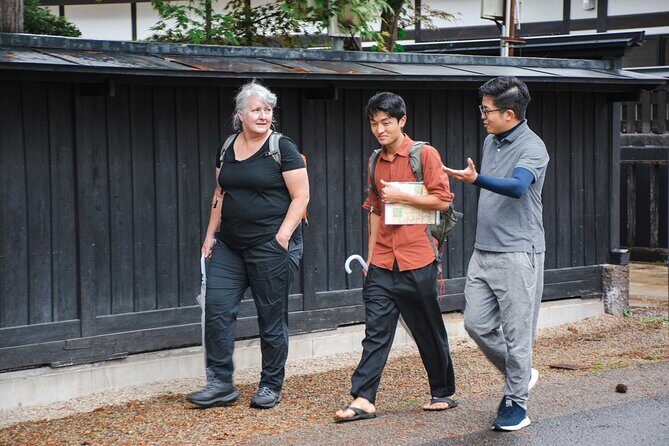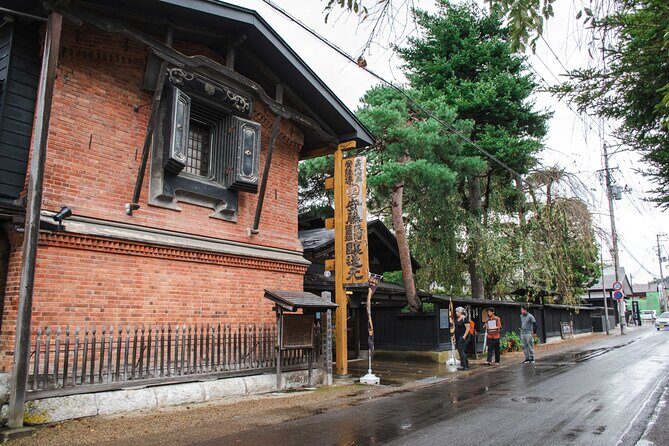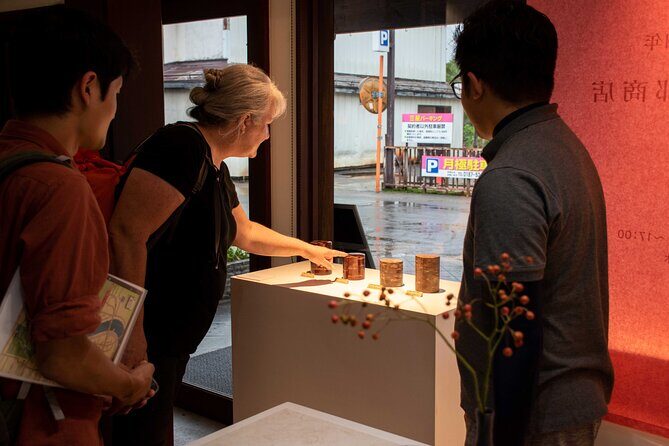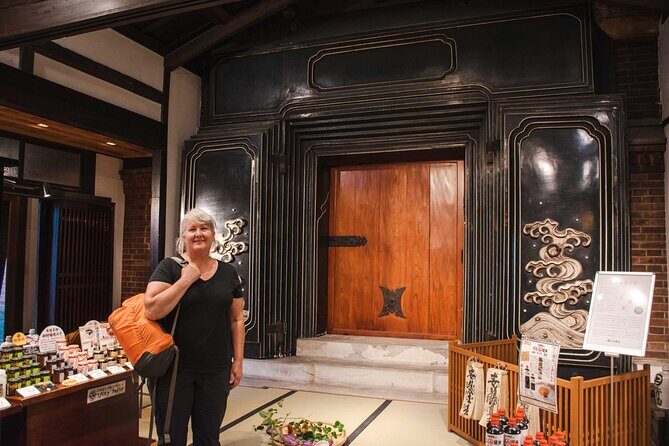Exploring Kakunodate with the Samurai Food Walk

This 2.5-hour guided tour in Kakunodate, Akita Prefecture, offers a delightful blend of local flavors, historic sights, and insider stories. For $106.88 per person, you’ll visit a series of carefully curated stops—sake shops, samurai residences, traditional sweet shops, and craft studios. Led by knowledgeable guides, it’s a chance to experience this hidden gem in a way that’s both intimate and informative.
What we love about this experience is how it balances culinary delights with cultural insights. The stops are thoughtfully chosen, giving you a taste of regional specialties like sake, miso, soy sauce, and local sweets. Plus, the opportunity to step inside authentic samurai homes makes history feel vivid and personal.
A potential consideration? The tour is designed for small groups—limited to just 8 travelers—so it’s not suited for those seeking a large, fast-paced sightseeing bus. Also, since it’s a walking tour through a historic district, good walking shoes are a must. If you enjoy learning about local culture through food and history, this tour is a perfect fit. It’s especially ideal for curious travelers who appreciate authentic experiences and don’t mind a leisurely pace.
Key Points

- Authentic Cultural Experience: Visit historic samurai residences and learn about Kakunodate’s Edo period significance.
- Regional Food & Drink: Sample local sake, miso, soy sauce, and traditional Japanese sweets, plus regional street food.
- Expert Guides: Guides are praised for their knowledge and ability to make history and culture engaging.
- Small Group Setting: With a maximum of 8 travelers, you’ll get personalized attention and local insights.
- Inclusive Entry & Tasting: All entrance fees and tastings are included, providing great value.
- Ideal for Food & History Enthusiasts: Perfect for those curious about Japan’s culinary and samurai heritage.
A Closer Look at the Samurai Food Walk
The Starting Point: Kakunodate’s Charm
The tour kicks off in the heart of Kakunodate, a town often called “Michinoku’s Little Kyoto” for its well-preserved Edo-period architecture. Meeting at a centrally located spot, we immediately sense the calm elegance of the town’s narrow streets and historic buildings. Here, our guide—Ginji, based on reviews—begins by sharing colorful anecdotes about Kakunodate’s history, setting the tone for an experience that’s as much about stories as it is about tastes.
Stop 1: Exploring Local Markets and Sweet Shops
Our first stops include a traditional Japanese sweet shop with over 100 years of history, where we sample mochi, manju, and dorayaki—each bite a reminder of Japan’s enduring confectionery craftsmanship. The shop’s owner shares stories about regional ingredients and seasonal sweets, making it more than just a snack.
Next, we visit a green grocery and a snack shop, each with its own unique offerings. From freshly picked vegetables to local street foods, these stops reveal what Kakunodate’s residents enjoy daily. As one reviewer put it, Ginji’s explanations make the food come alive, providing insight into local culinary customs.
Stop 2: Walking Through Samurai Residences
A highlight is wandering Kakunodate Bukeyashiki, the samurai residence street, often called “Michinoku’s Little Kyoto.” This historic district, protected as a National Important Preservation District, is a fairy-tale scene of traditional houses, some dating back to the Edo era.
We step inside actual samurai residences, gaining a personal glimpse into the lives of lower and middle-class warriors who served the Ashina and Satake clans. Ginji explains how these homes reflect social status and samurai culture, making history feel tangible. Visitors consistently praise the guide’s storytelling, with one saying, “Ginji was very informative and answered all our questions.”
Stop 3: Local Sake Tasting at Fujita
Next, we visit a sake shop where three different types of sake are sampled—an experience many travelers find both delicious and educational. The shop offers regional brands unique to Akita, some exclusive to the area, making this tasting a real treat for sake enthusiasts.
Reviews highlight the guide’s ability to explain sake nuances clearly, with one describing the experience as “highlighting the importance of rice in Kakunodate’s culture.” The shop also sells local beers and sake souvenirs, perfect for bringing home a taste of Akita.
Stop 4: Miso, Soy Sauce, and More at Ando Jozo Brewery
A trip to Ando Brewery introduces a world of traditional miso, soy sauce, and pickles. The original store, rebuilt in 1883, offers a nostalgic feel and an authentic look at Japan’s craft food production. During tastings, you’ll try soy sauce ice cream or miso macarons, a playful twist that’s surprisingly popular.
This stop is beloved for its informative tasting session and the chance to understand the painstaking process behind soy sauce and miso making. One reviewer mentions, “The soy sauce ice cream was a personal favorite—who knew soy sauce could be so good in dessert?”
Stop 5: Sweet Traditions at Fukushindo
Back in the Samurai Street area, Fukushindo is a charming shop where you sample manju and mochi—a sweet finish to the culinary journey. With over 140 years of history, it’s a delightful reminder of how traditional sweets remain a vital part of local culture.
Stop 6: Inside the Iwahashi Samurai House
Visiting this middle-class samurai family’s residence adds depth to our understanding of Kakunodate’s social structure. The house, remodeled in the late Edo period, showcases typical architecture and lifestyle. The tour includes explanations of how samurai lived, providing context that makes their history more accessible.
Final Stop: Crafting with Kaba-zaiku
The tour concludes with a visit to a workshop producing kaba-zaiku, an intricate craft made from mountain cherry bark. This traditional art form was developed during the Edo period and remains a rare skill today. Watching artisans craft inro and netsuke, you’ll gain appreciation for Japan’s handmade artistry.
What Reviewers Are Saying

Guests consistently praise Ginji’s storytelling and knowledge, describing him as friendly, engaging, and eager to answer questions. The mix of delicious food, historical insights, and authentic crafts leaves a strong impression. Comments like, “The food and drinks were delicious. I loved the soy sauce ice cream and kiritanpo,” underscore the memorable culinary highlights.
Several reviewers highlight the small group size, which fosters a personal experience and allows better interaction. The inclusion of all entrance fees and tastings enhances the overall value, making it a worthwhile investment for those interested in local cuisine and history.
On the Cons
The main consideration is that this is a walking tour with limited transportation, so comfortable shoes and moderate mobility are important. Also, at just over two hours, it’s a relatively short experience, but packed with meaningful stops, which many find just right.
How the Experience Adds Value

This tour isn’t just about ticking off sights; it’s about understanding Kakunodate through its flavors and homes. The combination of culinary tastings and cultural insights means you leave not only with a full stomach but also with stories and appreciation for the area’s traditions. The inclusion of regional sake and craft foods makes this a particularly appealing choice for food lovers and history buffs alike.
The price of around $107 includes all tastings, entry fees, and expert guidance—offering good value for a personalized, in-depth exploration. If you’re someone who enjoys small-group tours that emphasize authenticity, this experience will resonate well.
Who Should Consider This Tour?

It’s perfect for foodies, particularly those interested in Japanese sake, miso, and sweets. History buffs will appreciate the inside look at samurai residences and local crafts. It’s also suitable for travelers who want a relaxed, small-group experience that balances food, culture, and history in a charming setting.
Please note that it’s geared toward those who are comfortable walking and standing for periods. If you’re seeking a quick overview or large-group tour, this might not be the best fit.
FAQs

Is this tour suitable for all ages?
Yes, as long as participants are comfortable walking and standing. The tour offers a variety of tasting experiences and cultural insights that appeal to a broad age range.
Are dietary restrictions accommodated?
The tour focuses on regional specialties; while specific accommodations are not mentioned, it’s best to contact the provider if you have particular needs.
How much walking is involved?
Since the tour visits several historic sites and shops within Kakunodate, expect a good amount of walking, but it’s manageable for most travelers.
Is the tour suitable for non-Japanese speakers?
Yes. The guides are praised for their excellent English, making it easy to ask questions and learn about the sites and foods.
Does the tour include transportation?
No, transportation between stops is on foot, within the compact historic district.
What should I bring?
Comfortable shoes, a small bag for souvenirs, and an umbrella or raincoat if weather varies—rain gear is available for rent if needed.
Final Thoughts
The Samurai Food Walk in Kakunodate offers a carefully curated blend of culinary discovery and cultural history. It’s an excellent way to see a lesser-known side of Japan, especially if you love authentic foods and historic architecture. The small-group setting, knowledgeable guides, and inclusive tastings make it a memorable and worthwhile experience.
Whether you’re a dedicated food lover, a history enthusiast, or just someone eager to enjoy the charming atmosphere of Kakunodate, this tour provides a meaningful way to connect with local traditions. It’s not just a walk; it’s a chance to taste and touch Japan’s storied past in a real and personal way.
